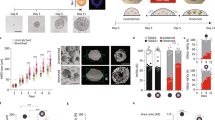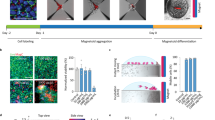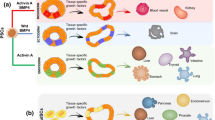Abstract
Organoids are a powerful model system to explore the role of mechanical forces in sculpting emergent tissue cytoarchitecture. The modulation of the mechanical microenvironment is most readily performed using synthetic extracellular matrices (ECM); however, such materials provide passive, rather than active force modulation. Actuation technologies enable the active tuning of mechanical forces in both time and magnitude. Using such instruments, our group has shown that extrinsically imposed stretching on human neural tube organoids (hNTOs) enhanced patterning of the floor plate domain. Here, we provide a detailed protocol on the implementation of mechanical actuation of organoids embedded in synthetic 3D microenvironments, with additional details on methods to characterize organoid fate and behavior. Our protocol is easy to reproduce and is expected to be broadly applicable to investigate the role of active mechanics with in vitro model systems.
Access this chapter
Tax calculation will be finalised at checkout
Purchases are for personal use only
Similar content being viewed by others
References
Cayuso J, Martí E (2005) Morphogens in motion: growth control of the neural tube. J Neurobiol 64:376–387
Subramanian L, Calcagnotto ME, Paredes MF (2020) Cortical malformations: lessons in human brain development. Front Cell Neurosci 13:576
Nikolopoulou E, Galea GL, Rolo A et al (2017) Neural tube closure: cellular, molecular and biomechanical mechanisms. Development 144(4):552
Colas JF, Schoenwolf GC (2001) Towards a cellular and molecular understanding of neurulation. Dev Dyn 221:117–145
Ishihara K, Ranga A, Lutolf MP et al (2017) Reconstitution of a patterned neural tube from single mouse embryonic stem cells. In: Tsuji T (ed) Organ regeneration: 3D stem cell culture and manipulation. Methods in molecular biology, vol 1597. Humana, New York, pp 43–55
Ranga A, Girgin M, Meinhardt A et al (2016) Neural tube morphogenesis in synthetic 3D microenvironments. Proc Natl Acad Sci U S A 113(44):E6831–E6839
Rammensee S, Kang MS, Georgiou K et al (2017) Dynamics of mechanosensitive neural stem cell differentiation. Stem Cells 35(2):497–506
Thomson JA, Itskovitz-Eldor J, Shapiro SS et al (1998) Embryonic stem cell lines derived from human blastocysts. Science 282(5391):1145–1147
Karzbrun E, Khankhel AH, Megale HC et al (2021) Human neural tube morphogenesis in vitro by geometric constraints. Nature 599(7884):268–272
Chang YJ, Tsai CJ, Tseng FG et al (2013) Micropatterned stretching system for the investigation of mechanical tension on neural stem cells behavior. Nanomedicine 9(3):345–355
Abdel Fattah AR, Daza B, Rustandi G et al (2021) Actuation enhances patterning in human neural tube organoids. Nat Commun 12(1):1–13
Abdel Fattah AR et al (2023) Targeted mechanical stimulation via magnetic nanoparticles guides in vitro tissue development. Nat Commun 14:5281. https://doi.org/10.1038/s41467-023-41037-8
Abdel Fattah AR, Ranga A (2020) Nanoparticles as versatile tools for mechanotransduction in tissues and organoids. Front Bioeng Biotechnol 8:240. https://doi.org/10.3389/fbioe.2020.00240
Abdel Fattah AR, Grebenyuk S, de Rooij LPMH, Salmon I, Ranga A (2023) Neuroepithelial organoid patterning is mediated by a neighborhood watch mechanism. Cell Reports 42:113334. https://doi.org/10.1016/j.celrep.2023.113334
Gjorevski N, Lutolf MP (2017) Synthesis and characterization of well-defined hydrogel matrices and their application to intestinal stem cell and organoid culture. Nat Protoc 12(11):2263–2274
Rosenzweig DH, Solar-Cafaggi S, Quinn TM (2012) Functionalization of dynamic culture surfaces with a cartilage extracellular matrix extract enhances chondrocyte phenotype against dedifferentiation. Acta Biomater 8(9):3333–3341
Supek F, Bošnjak M, Škunca N et al (2011) REVIGO summarizes and visualizes long lists of gene ontology terms. PLoS One 6(7):e21800
Eden E, Navon R, Steinfeld I et al (2009) GOrilla: a tool for discovery and visualization of enriched GO terms in ranked gene lists. BMC Bioinform 10(1):1–7
Acknowledgments
This work was supported by the FWO grants G087018N, G0ACA24N and I009718N, FWO postdoctoral fellowship 1217220 N, FWO doctoral scholarships 11K722N and 11M5323N, Interreg Biomat-on-Chip grant and Vlaams-Brabant and Flemish Government co-financing, KU Leuven grants C14/17/111, C32/17/027, IDN/22/012 and IDN/20/007, King Baudouin Foundation grant J1810950-207421 and an Allen Distinguished Investigator Award, a Paul G. Allen Frontiers Group advised grant of the Paul G. Allen Family Foundation.
Author information
Authors and Affiliations
Corresponding authors
Editor information
Editors and Affiliations
Rights and permissions
Copyright information
© 2024 The Author(s), under exclusive license to Springer Science+Business Media, LLC, part of Springer Nature
About this protocol
Cite this protocol
Sgualdino, F., Mattolini, L., Jimenez, B.D., Patrick, K., Abdel Fattah, A.R., Ranga, A. (2024). Mechanical Actuation of Organoids in Synthetic Microenvironments. In: Sumbalova Koledova, Z. (eds) 3D Cell Culture. Methods in Molecular Biology, vol 2764. Humana, New York, NY. https://doi.org/10.1007/978-1-0716-3674-9_15
Download citation
DOI: https://doi.org/10.1007/978-1-0716-3674-9_15
Published:
Publisher Name: Humana, New York, NY
Print ISBN: 978-1-0716-3673-2
Online ISBN: 978-1-0716-3674-9
eBook Packages: Springer Protocols




